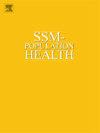Trajectories of personal agency by gender and pubertal development among adolescents in Kinshasa: Longitudinal evidence from the GlobalEarly Adolescent Study
IF 3.6
2区 医学
Q1 PUBLIC, ENVIRONMENTAL & OCCUPATIONAL HEALTH
引用次数: 0
Abstract
Background
Empowerment research has largely focused on adult women with little focus on younger adolescents. Additionally, despite recognition that empowerment is a process, few studies have longitudinally explored its development.
Methods
We used secondary data from four waves of the Global Early Adolescent Study to explore trajectories in the development of three domains of agency (i.e. the internal processes composing empowerment) - Freedom of Movement, Voice, and Decision-Making - for 1188 boys and 1153 girls in Kinshasa, Democratic Republic of Congo. Respondents were age 10–14 at enrollment and followed through age 14–18. We created scales for each domain and conducted gender- and age-stratified latent growth curve modeling with random effects, comparing age 10–14 to age 15–18, accounting for clustering within individuals over waves. We examined the role of puberty within each domain in the analysis of age 10–14.
Results
Scores across all domains increased with age for boys and girls, with the exception of Voice amongst boys 10–14. Rates of change varied by age group and gender; for boys, scores increased at a faster rate for older boys relative to younger boys for Freedom of Movement (ß(10-14): 3.98 versus ß(15-18): 6.12) and Voice (ß(10-14): .50 versus ß(15-18): 2.54). Relative to younger girls, scores amongst older girls increased at a faster rate for Freedom of Movement (ß(10-14): 1.76 versus ß(15-18): 3.72) and a slower rate for Decision-Making (ß(10-14): 6.41 versus ß(15-18): 2.80). Puberty was associated with significant increases in scores across all domains for both genders, with the exception of Decision-Making for girls.
Interpretation
Young people develop/acquire different forms of agency at different stages of adolescence and development is not uniform across forms. Gender inequalities in agency amplify at puberty, signaling the need to intervene at or before this critical stage of development.
金沙萨青少年按性别和青春期发育划分的个人代理轨迹:来自全球早期青少年研究的纵向证据
背景赋权研究主要集中于成年女性,很少关注青少年。我们利用全球早期青少年研究(Global Early Adolescent Study)四次调查的二手数据,对刚果民主共和国金沙萨的 1188 名男孩和 1153 名女孩的三个代理领域(即构成赋权的内部过程)--行动自由、话语权和决策--的发展轨迹进行了探索。受访者入学时年龄为 10-14 岁,跟踪调查至 14-18 岁。我们为每个领域创建了量表,并利用随机效应进行了性别和年龄分层的潜在成长曲线建模,将 10-14 岁与 15-18 岁进行了比较,同时考虑到了各波次中个体的聚类情况。在对 10-14 岁年龄段的分析中,我们研究了青春期在各领域中的作用。结果除了 10-14 岁男孩的语音之外,男孩和女孩所有领域的分数都随着年龄的增长而增长。变化率因年龄组和性别而异;就男孩而言,相对于年龄较小的男孩,年龄较大的男孩在 "行动自由 "方面的得分上升较快(ß(10-14):3.98对ß(15-18):6.12)和声音(ß(10-14): .50 对 ß(15-18):2.54).与年龄较小的女孩相比,年龄较大的女孩在 "行动自由 "方面的得分上升较快(ß(10-14): 1.76 对 ß(15-18): 2.54):1.76 对 ß(15-18):3.72),而在决策能力方面的上升速度较慢(ß(10-14):6.41 对 ß(15-18):2.80).青春期与男女两性所有领域得分的显著增加有关,但女孩的决策领域除外。在青春期,代理能力方面的性别不平等会扩大,这表明有必要在这一关键发展阶段或之前进行干预。
本文章由计算机程序翻译,如有差异,请以英文原文为准。
求助全文
约1分钟内获得全文
求助全文
来源期刊

Ssm-Population Health
PUBLIC, ENVIRONMENTAL & OCCUPATIONAL HEALTH-
CiteScore
6.50
自引率
2.10%
发文量
298
审稿时长
101 days
期刊介绍:
SSM - Population Health. The new online only, open access, peer reviewed journal in all areas relating Social Science research to population health. SSM - Population Health shares the same Editors-in Chief and general approach to manuscripts as its sister journal, Social Science & Medicine. The journal takes a broad approach to the field especially welcoming interdisciplinary papers from across the Social Sciences and allied areas. SSM - Population Health offers an alternative outlet for work which might not be considered, or is classed as ''out of scope'' elsewhere, and prioritizes fast peer review and publication to the benefit of authors and readers. The journal welcomes all types of paper from traditional primary research articles, replication studies, short communications, methodological studies, instrument validation, opinion pieces, literature reviews, etc. SSM - Population Health also offers the opportunity to publish special issues or sections to reflect current interest and research in topical or developing areas. The journal fully supports authors wanting to present their research in an innovative fashion though the use of multimedia formats.
 求助内容:
求助内容: 应助结果提醒方式:
应助结果提醒方式:


